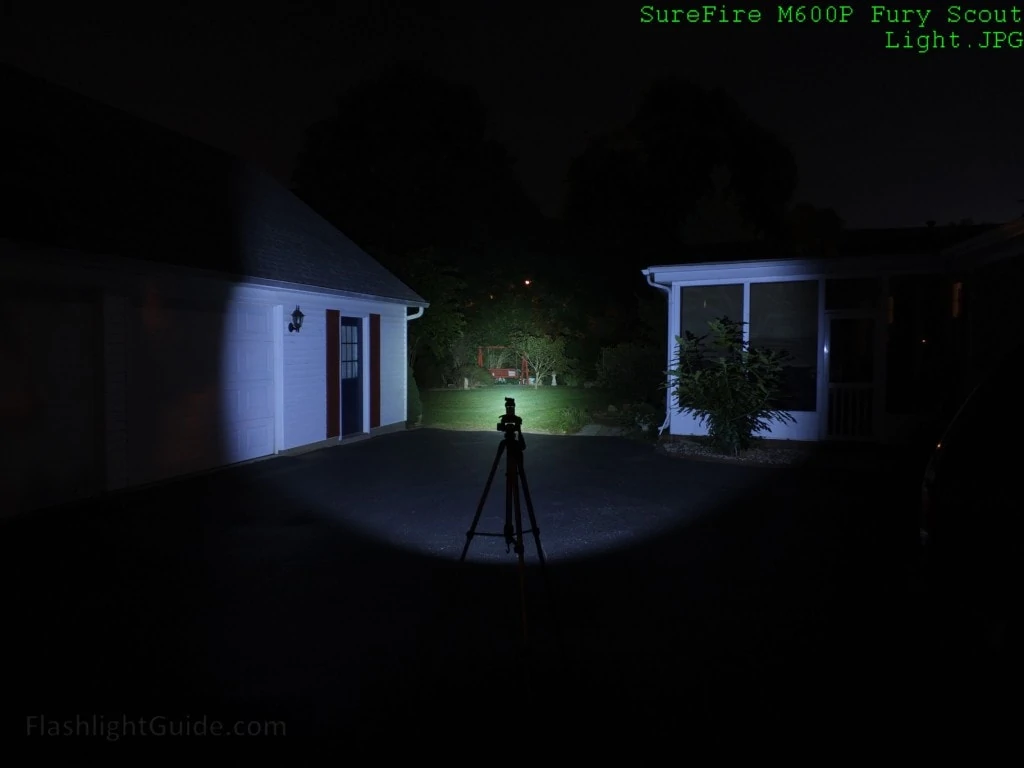Beam Tint
Our blog post on Beam Projection featured two photographs provided by FlashlightGuide.com which exemplified the differences between a hard-edge beam created by a reflector-based flashlight and the tactically-superior soft-edge beam created by an Elzetta optical (TIR) lens. The same photographs are also helpful to contrast the difference between beam tint, or coloration.
The first photo shows the typical bluish beam coloration that is found in most tactical flashlights on the market. Although bluish tints are associated with hotter emissive temperatures (measured in degrees Kelvin (K)), they are often referred to as “cool” tints (described for the subjective feel the color supposedly evokes). The second photo shows the neutral beam tint generated by an Elzetta High Output AVS Head (a neutral tint is neither cool blue nor “warm” yellow). Cool tints are used in most LED flashlights primarily because they offer higher lumen ratings that play well in sales and marketing efforts. Unfortunately these bluish beams have serious disadvantages for tactical users.
As easily observed in the photos, the cool-tint beam paints objects with an artificial blue hue. The garage on the left side of the photos is covered with white siding yet the cool-tint beam makes the garage appear blue. The shutters flanking the entry door are a deep red color yet the cool-tint beam renders them nearly black. The screened-in porch on the right is actually a very light blue color yet its color is indistinguishable from the garage when illuminated with the cool-tint beam. Contrast this with the second photo where illumination was provided by an Elzetta Modular Flashlight with High Output AVS Head. With Elzetta’s neutral tint, the garage siding is clearly white while the shutters are recognizably red and, upon close inspection, the light blue color of the porch can be distinguished from the white garage. The neutral-tint of the Elzetta beam enables accurate color rendition whereas the cool-tint beam creates unnatural color distortions.
In tactical applications, where one may search for and identify persons based on the color of their vehicles or apparel, faithful color perception is essential. Imagine searching for a suspect known to be wearing a red shirt and last seen near a light blue house. With a cool-tint flashlight the red shirt will appear black and every white residence in the neighborhood will seem to match the described blue house. With a neutral-tint beam, however, colors are accurately observed and proper identification may be achieved quickly. All Elzetta Alpha Models and Bravo and Charlie Models equipped with High Output AVS Heads produce neutral-tint beams.
Further benefits of neutral-tint beams manifest when smoke, haze, or fog is present. In such conditions, cool-tint beams tend to “splash back” with greater harshness than neutral or warm beams. While such harshness is generally more of a perceived phenomenon than a quantifiable one, most people find cool-tint beams to produce more glare in adverse conditions than neutral-tint light.
The pursuit of high lumen ratings has led manufacturers to use cool-tint LED’s in the vast majority of tactical flashlights today. Unfortunately, like so many other features which are driven by Marketing Departments rather than thoughtful user-based engineering, these bluish beams sacrifice real-world performance. When faithful color rendition is important, as it is in tactical applications, look for a flashlight with a neutral-tint beam. After all, there is nothing “cool” about being blue.


